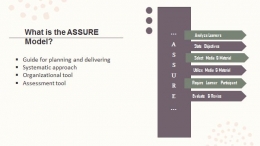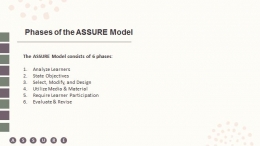In implementing ASSURE Model of Instructional Design, the teacher should follow these significant characteristics:
- Analyze learners
- State objectives
- Select, modify, and design
- Utilize media & material
- Require learner participation
- Evaluate & revise
1. Analyze Learners
The learners should be studied prior to the conception of the design. Learners' skills, prior knowledge, attitude, age, grade and learning style must be taken into consideration. According to Hap Aziz, "In order to select the best media and technology for the delivery of instructional content, it is essential to identify and analyze the audience". (Hap Aziz, OIT. 1999).
The instructor will analyze learners based on three features:
- General characteristics, which include the number of students at the class, age, level, gender, socio economic status of the students, exceptionality, cultural and ethical diversity of the learners.
- Entry competencies, this means the description of knowledge which the teacher expects the learners have known. Like knowledge, skills and attitudes about the topic.
- Learning style, this refers to psychological differences of the learners that determine how a person perceives, interacts with and responds emotionally to the learning environment. This includes multiple intelligence, perceptual preference and strength, information processing habits (concrete sequential learners, concrete random, abstract sequential and random sequential learners), motivation, and physiological.
2. State Objectives and Standards
The lesson objectives must be clear and sound. The instructor must state what the learner will achieve in the end. The most important objective can be summarized as follows: objective about intended audience, their learning behavior, learning conditions such as equipments, maps, dictionaries, note taking and the degree of proficiency of a learner to be eligible to continue further. Statement of the objective also involves systematic planning and procedure (Daniel Callison 2002).
The instructor should be able to observe students behavior as a result of the model. This is very important for further evaluation of the model. According to Gagne, "It is necessary to translate the needs and goals into objectives that are sufficiently specific to guide the instructor in teaching and the learner in studying" Gagne, R. M. Briggs, L. J, & Wager, W.W. (1992).
3. Select Media, Technology, and Materials
Smaldino (1996) suggested the following criteria for selecting technology and media: 1) Alignment with standard outcome and objective 2) Accurate to the current information 3) Age appropriateness 4) Interest level and engagement 5) Technical quality 6) Ease for use 7) Bias free 8) User guide and direction
Relevant media and content materials such as sound, graphics, text animations and videos must be selected for effective learning outcomes. "As we know, instructional technology the convergence of computer and communications technology within the realm of teaching and learning has already had profound effects on education at all levels." (Philip H. Swain 2003)
The duty of the instructor is to bridge the new technology with the existing materials. Instructors must understand how technology is used to educate learners. Because of the exciting attributes of technology the question of what to teach and how to teach must be addressed (Judith J. Lambrecht 1999).










